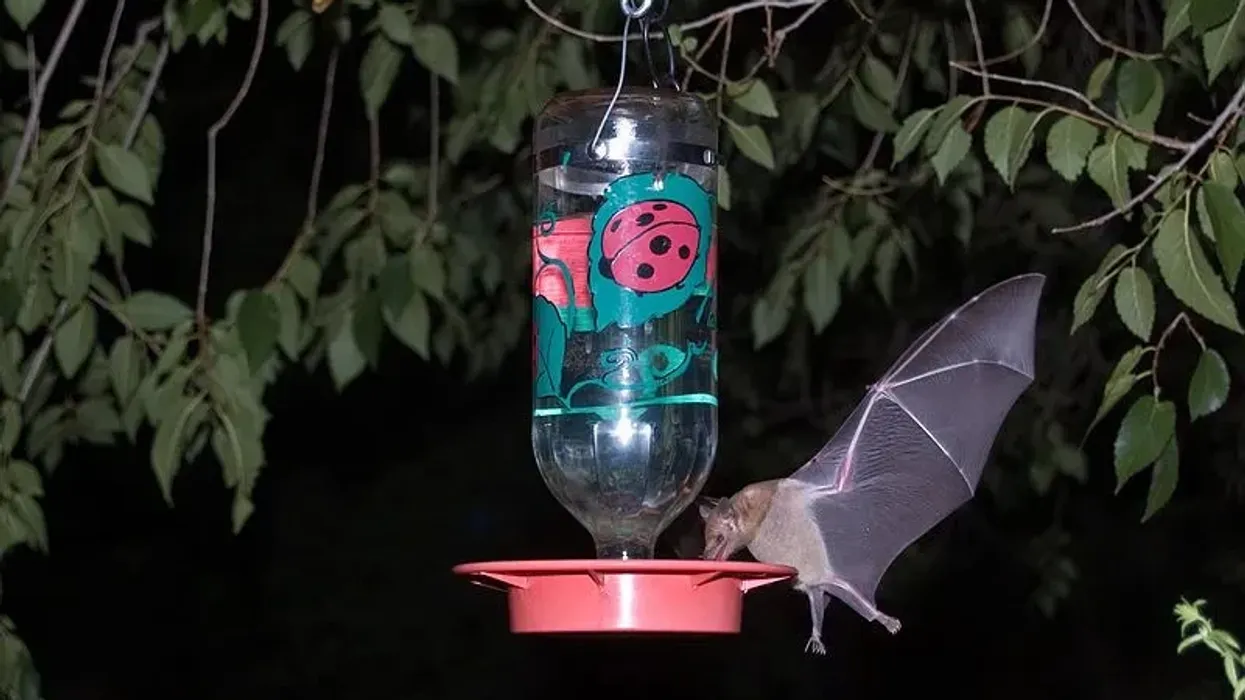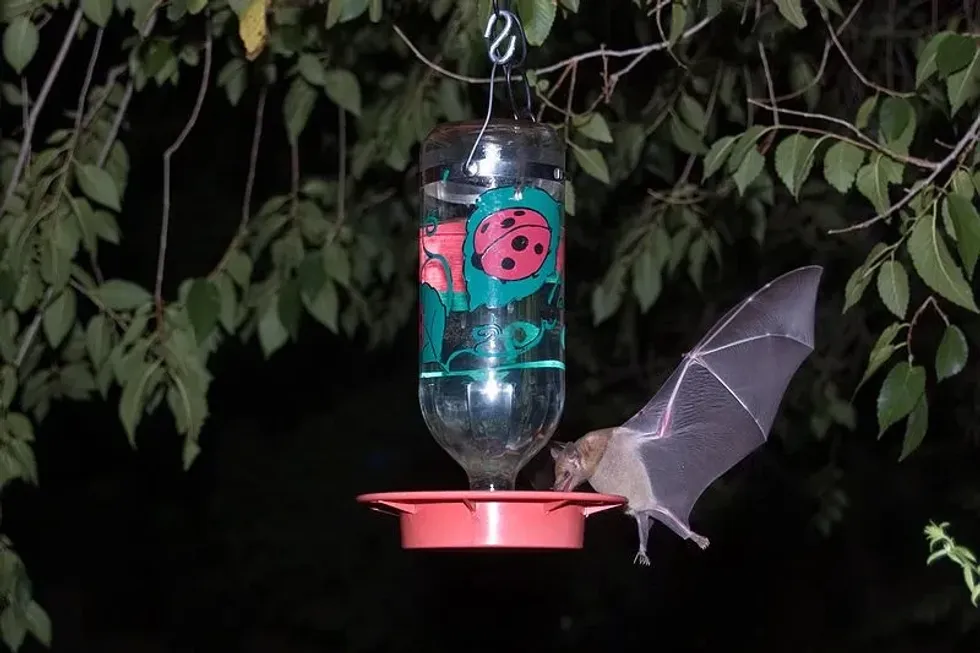Bats have a reputation for being the evilest mammal in the animal kingdom. Since they are often associated with vampires, haunted houses, and eerie environments. However, bats play an essential role in pollinating over 500 plant species and seed dispersal.
However, unlike fuzzy little bees, colorful butterflies, and other daytime pollinators, bats work at night and are underappreciated for their efforts. Many plant species are entirely dependent on these animals to reproduce. They would be extinct without them.
Is it interesting to learn about a bat whose co-evolution cases are surprising? One such example is the tube-lipped nectar bat (Anoura fistulata) and the Centropogon nigricans plant.
They coexist side by side in the same environment because the flower's neck is too long for other bats to reach down with their tongues for pollination.
This bat has a tongue that is about 150 percent of its body length and can easily hit the bottom of the blossom. After licking the sticky sweet, the bat retracts its oversized tongue and flies away, bringing pollen to the next plants.
Read our other exciting articles including hoary bat facts and numbat facts for more information about bats.
Tube-Lipped Nectar Bat Interesting Facts
What type of animal is a tube-lipped nectar bat?
The tube-lipped nectar bat (Anoura fistulata) is a bat species from Ecuador. This bat has the most elongated tongue, allowing it to drink nectar from the deepest flowers.
What class of animal does a tube-lipped nectar bat belong to?
The tube-lipped nectar bat (Anoura fistulata) is a member of the Mammalia class, in the order Chiroptera. This bat is a member of the Phyllostomidae family, specifically the genus Anoura.
How many tube-lipped nectar bats are there in the world?
It's still unknown how many tube-lipped nectar bats exist. However, we know that bats can be found on any continent except the coldest and most remote areas of the world, like the Arctic, Antarctica, and a few islands.
Do you know that there are between 900 and 1,200 species of bats globally, accounting for one-fifth of the total mammalian population, making them the second largest order after rodents!
Where does a tube-lipped nectar bat live?
So far, these bats have only been discovered in Ecuador, South America, by a group of scientists led by Nathan Muchhala, and these scientists are on further research to confirm their existence all over the world.
What is a tube-lipped nectar bat's habitat?
These bats have only been found in the cloud forests of Ecuador until now, feeding on nectar and fruit from a variety of plants. However, the bat has recently been found in a new location, Madidi National Park in Bolivia.
Who do tube-lipped nectar bats live with?
Like other bats, tube-lipped nectar bats, when not flying, roost or hang upside down from. Some solitary roosting bats live alone and are devoted to a single roosting spot, while on the other hand, social species that roost in groups of large colonies about hundreds, thousands in nature.
Mostly, males may live alone or in harems in some cases, while females tend to roost with other individuals and their pups.
Mothers and pups form a social connection, and young bats even learn food habits from them. When they are unwilling to leave the nest, mothers practically push the babies out of the roost.
How long does a tube-lipped nectar bat live?
Scientists are working to figure out how long these bats live. However, they may live for 20–30 years, like other species in the same family.
How do they reproduce?
Like other similar species, after a male and female bat mate, the female gives birth to a single pup or, in rare cases, two, with a gestation period of around nine months. These puppies have open ears, open eyes, and the first set of deciduous teeth, in addition to being covered in fur.
What is their conservation status?
The conservation status of these bats is termed as Data Deficient.
Tube-Lipped Nectar Bat Fun Facts
What do tube-lipped nectar bats look like?

*Please note that this is an image of a Mexican long-tongued bat, not a tube-lipped nectar bat. If you have an image of a tube-lipped nectar bat, please let us know at hello@kidadl.com
Anoura fistulata is about the size of a mouse, measuring about 2 in (5cm) in length, but its tongue is about 3.3 in (8.5 cm).
The length of its tongue ranks second among vertebrates, and it is the longest of all mammals. It got its name from its tube lip, which refers to its lower lip, which extends 0.12-0.19 in (3.3–4.8 mm) beyond the upper lip and is rolled into a funnel shape.
It is observed that the tube-lipped nectar bat tongue reaches down into the rib cage, and its base is between the heart and sternum.
How cute are they?
Bats have long been associated with scary witches, ghosts, and monsters, but as bats are researched, they are seen as important members of the natural world, playing a critical role in the ecosystem.
The sight of this bat can be adorable when you encounter them in the wild with the prolonged length of its tongue pollinating the flowers moreover, they are the sole pollinator of the plant species Centropogon nigricans.
Nathan muchhala presumes these bell-shaped flowers and bat are a co-evolution or influence each other and emerged side-by-side.
How do they communicate?
There is no information about how tube-lipped nectar bat communicates. Still, being a member of the Phyllostomidae family, these bats may use scent to play a remarkable role in communication during reproduction.
On the other hand, echolocation is produced by these bats emitting high-frequency sound waves through their mouth or nose and listening for the echo they can detect insects to eat.
In addition to echolocation, scientists discovered that the bats of this family rely on vision and sometimes communicates vocally. In addition, tactile communication exists between mothers and their children and even between mates in the roost.
How big is a tube-lipped nectar bat?
Anoura fistulata is about the size of a mouse, only 2 in (5 cm) long, but its tongue one and a half times its body length, which is more than twice when compared to the length of any nectar bat's tongues.
In terms of vertebrates, a tongue this size is second to the chameleon in terms of length, and it is the longest of all mammals.
How fast can a tube-lipped nectar bat fly?
While research is needed to determine the speed of these bats, in general, we know that bats can fly at speeds of up to 60 mph (100 kph).
How much does a tube-lipped nectar bat weigh?
According to research led by Nathan Muchhala, the weight of these bats ranges from 0.02-0.04 lb (9.5-17.5 gm).
What are the male and female names of the species?
The male and female of these bat species have no particular name to specify their characteristics. However, on the other hand, a group of these bats is mentioned as a camp, cloud, or colony.
What would you call a baby tube-lipped nectar bat?
There isn't a particular word for it, but in general, a baby bat is referred to as a pup.
What do they eat?
These nectar bats feed on the nectar and also get their nutrition from the pollen of various plants; additionally, they also consume insects.
Are they dangerous?
These bats aren't harmful to humans. These, on the other hand, are home to a slew of lethal viruses; when these come in contact with animals or humans, they may cause severe illness.
Would they make a good pet?
They are complex creatures, and it would not be easy to take adequate care of them even if you wanted to. In general, all bats like to fly and do not do well when restricted to a cage, so keeping them as pets s not recommended, and it would better to leave them in their natural habitat.
Did you know...
When this bat feeds from flowers, it brushes against the petals. As a result, pollen from the blossom falls on the bat's head. When the bat visits the next plant, the pollen from the flower is sprinkled on them. This will help in the formation of seeds, which spread and develop into new blossom areas- making them great gardeners.
Why is the tube-lipped nectar bat endangered?
Anoura fistulata is classified as Data Deficient by the International Union for Conservation of Nature and Natural Resources (IUCN) because there is insufficient information about its abundance and distribution to classify its conservation status accurately hence these species cannot be considered as endangered.
This species was first identified in 2005 and appeared to be endemic to Ecuador; however, further study is needed to confirm its areas of existence. Despite this, they may face challenges due to habitat destruction, poaching, and pollution.
In addition, diseases such as white-nose syndrome, waste, and chemical usage limit the number of insects or pesticides that accumulate in their bodies as a result of consuming them as diet can also affect their population.
How did the tube-lipped nectar bat get its name?
In its species name, the term fistulata is derived from the Latin word fistula, which means tube, which refers to the tube-like lower lip. Moreover, the tongue of these bats is unmatched.
According to the experts, it has the longest tongue of any animal, measuring 3.3 in (8.5 cm) in length compared to its own body length it is one and a half times.
Here at Kidadl, we have carefully created lots of interesting family-friendly animal facts for everyone to discover! Learn more about some other mammals from our fruit bat facts and Mexican free-tailed bat facts pages.
You can even occupy yourself at home by coloring in one of our free printable tube-lipped nectar bat coloring pages.
*Please note that the main image is of a Mexican long-tongued bat, not a tube-lipped nectar bat. If you have an image of a tube-lipped nectar bat, please let us know at hello@kidadl.com








